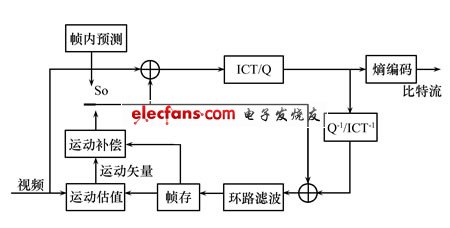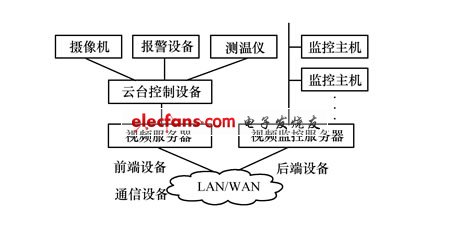With the rapid development of computer, video coding and network transmission technology, video surveillance technology has made a huge leap. Video coding technology has attracted the attention of everyone as a key technology for remote video surveillance. At present, the image compression standards H.261 and MPEG-1, which are mainly used in video surveillance systems, have limitations in adaptability and poor user interaction in applications. Video coding standards such as MPEG-2, MPEG-4, H.263, and H.264 generated in recent years provide higher data compression ratios, especially H.264 with high quality, low bit rate, and strong adaptability. The features are increasingly being used in video surveillance systems.
This article refers to the address: http://
Due to the above standards, there are certain problems in patent pool fees, intellectual property rights and technical implementation complexity, which restricts their development. Whether we can establish a video coding standard with independent intellectual property rights and the same performance or better than other standards has become an important issue for us. In this case, AVS (Audio Video Coding Technology Standard) has entered our sight.
1 AVS video coding standard
(1) AVS main technical improvements
AVS uses a number of advanced technologies to ensure its performance, which is a new standard that is more advantageous. The second part of the AVS standard (AVS1-P2 hereinafter referred to as the AVS video standard) completed at the end of 2003 is mainly for high-definition, high-quality digital television broadcasting, digital storage media and other related applications. It has four major characteristics: high performance, encoding efficiency is more than 2 times higher than MPEG-2, equivalent to H.264 encoding efficiency; algorithm complexity is lower than H.264; hardware and software implementation costs are lower than H.264; patent The licensing model is simple and the cost is significantly lower than similar standards.
The AVS video standard uses a technical framework similar to H.264 (Figure 1), including transform, quantization, entropy coding, intra prediction, inter prediction, loop filtering and other technical modules.

figure 1
The main advanced technologies for implementing the AVS video standard are as follows.
Average information coding
First, AVS uses the k (k = 0, 1, 2, 3) order Exp-Golomb (exponential Columbus) encoding, CBP (macroblock coding template), macroblock mode and motion vector are encoded by 0th order Columbus code. The quantized coefficients use all four index Columbus codes and are encoded using 2D-VLC. Due to the adjustment of the Exp-Golomp encoding table, the AVS decoder does not need to store these encoding tables. Syntax elements can be decoded using a simple analysis with a selectable lookup table. The 19 mapping tables defined by AVS, although occupying less than 2Kbytes of space, are well adapted to different allocations and have high coding capabilities.
Conversion and quantification
Unlike H.264 and MPEG-2, AVS uses 8x8 integer conversion. In order to reduce the rounding error in dequantization and inverse conversion, AVS also has a special program set up, and various operations can be completed in 16 bits.
Intra prediction
The AVS video standard employs intra prediction techniques that improve the macroblock performance of intra coding. Compared to H.264, AVS defines five modes for 8x8 luma blocks and four modes for 8x8 chroma blocks.
Reference screen
In the conventional video coding standard (such as MPEG-2), the bidirectional predictive coding picture (B picture) is usually based on the previous picture and/or the latter picture. Although the predictive coded picture (P picture) predicts the current picture using only the previous picture, the actual reference buffer space in the decoder is equivalent to twice as large as the picture. The AVS completely uses the reference buffer for P-buffer encoding. The P picture can be referenced by the two adjacent I/P pictures. Therefore, while the coding efficiency is improved, the occupied reference buffer space is still the same as MPEG-2. .
B picture symmetry mode
AVS replaces the interpolation mode of the existing coding standard with a symmetric mode. Only the forward motion vector is coded, and the reverse motion vector is obtained by the relationship between forward and reverse. Therefore, at most one direction of the motion vector needs to be encoded in the B macroblock of the AVS.
Weighted prediction
AVS's weighted prediction function can greatly improve coding efficiency, especially in scene transitions and lighting changes. Weighted prediction uses a simple linear pattern, so parameters can be encoded within the predicted image header. But each macroblock is free to choose whether to use weighted prediction.
Deblocking filter
Block-based video coding often produces block artifacts, which become more noticeable at low bit rates. To solve this problem, AVS defines an adaptive loop deblocking filter to improve decoded video quality. In addition to picture boundaries or slice boundaries, filtering can also be used for the boundaries of luminance and chrominance blocks. The strength of the filtering depends on the type of macroblock, the quantization step, the motion vector, and the difference between the blocks.
Interlaced coding
When entering an interlaced sequence, a picture can be encoded in either one frame or two fields (top field and bottom field). Only the picture layer adaptation between frames and fields can be used for the current version. When two-field coding is used, the previous field is predicted by the previous decoding field, and the latter field is predicted by the previous field and the previous decoding field. Two fields share one image header, but they should belong to different slices.
(2) Comparison of AVS and H.264
Video information is usually massive information, which requires a large amount of storage space and transmission bandwidth. The key to video standard research is to optimize the algorithm to ensure the image visual effect is not distorted, eliminate the redundancy of video data, and compress the video data to the maximum extent.
Compared with the current best performance H.264 standard, the AVS decoding complexity is equivalent to 30% of H.264 in the case of similar image quality, and the AVS encoding complexity is equivalent to 70% of H.264. The lower the complexity, the less system resources are occupied, and the system efficiency is correspondingly increased. The specific technology module complexity analysis is shown in Table 1.
2 AVS application in video surveillance system
(1) Structure of video surveillance system
Generally, the video surveillance system can be divided into three parts: a front-end device, a communication device, and a back-end device. Its structure is shown in Figure 2.

figure 2
Front-end devices mainly include video servers and other related devices. The pan/tilt controller can control the camera to rotate the focus, and has the functions of video switching, receiving alarms, and receiving measurement temperature. The video server is responsible for digitizing the video and compressing the image by video encoding, and can adjust the pan/tilt controller through the received front-end control signal.
Back-end devices mainly include video surveillance servers and monitoring hosts. The video monitoring server receives the compressed video and other alarms, temperature and other information sent by the front-end video server, and then forwards it to the corresponding monitoring host. The monitoring host sends a control command according to the obtained monitoring information.
(2) Application of AVS in video surveillance system
Video digitization and video encoding compression are implemented in the front-end video server. We can encode the video information using the AVS standard and decode it in the back-end device. The advantages of doing this are as follows.
Compression ratio and image quality
In the video surveillance transmission system, in order to occupy the transmission bandwidth together with other data, in the case of ensuring the quality of the video image, the bandwidth occupied by the transmission video needs to be as small as possible, and the video encoding and decoding is required to be efficient and the compression ratio is high.
The AVS standard provides continuous, smooth high quality, and under the same picture quality, AVS has similar compression ratio to H.264, and saves 64% of the code stream compared with the previous generation encoding standard MPEG-2, which is more economical than MPEG-4. 39% of the transmission stream, and through the improvement of traditional intra prediction, inter prediction, transform coding and entropy coding algorithms, the coding efficiency and image quality of AVS are further improved on the basis of previous standards.
Network adaptability
In the video surveillance transmission system, depending on the network, the transmission bandwidth that can be utilized is also different. How does AVS video adapt to different bandwidth networks for transmission?
AVS specifies different grades and levels. The grades and levels impose various restrictions on the bit stream, and also specify the encoding and decoding capabilities required for encoding and decoding a particular bit stream. The grade is a subset of the prescribed grammar, semantics and algorithms. The code and decoder that meet the requirements of a certain grade must fully support the subset defined by the grade; the level is the limit of the syntax element and the syntax element parameter value under a certain grade. Collections, when given a grade, different levels often mean differences in code, decoder capabilities, and memory capacity. We can adopt different grades and levels according to different network transmission capabilities and application quality requirements.
Sensitivity and robustness of motion detection
The sensitivity and robustness of motion detection is a key indicator of video surveillance systems. It is the basis of image tracking and real-time alarm. In traditional motion detection methods, a single criterion (signal energy threshold control) is generally used to determine the occurrence of motion. Now we can use AVS motion compensation technology to detect motion in video surveillance. For example, the motion prediction of AVS standard has 1/4 pixel precision, the calculation of motion vector is finer, and the motion information in the image is better depicted. The AVS standard adopts weighted motion compensation technology, which can remove the local light and dark changes of the image and local Or the similarity and correlation caused by the slight jitter of the overall picture.
Independent standardization
AVS is an audio and video coding technology standard independently developed by China for a wide range of digital video. It is an open standard based on independent technology and some open technologies. It properly solves the problem of patent licensing, and at the same time takes into account the contradiction between performance and implementation complexity. . China's growing industrial strength and market also provide a good soil for its development.
3 Conclusion
As a self-developed audio and video coding standard, AVS has obvious advantages over other source standards, especially the high coding efficiency, relatively low complexity and low patent cost, which will effectively promote the development of video surveillance technology. .
70-90W Solar Street Lights,70W Solar Street Light,80W Solar Street Light,90W Solar Street Light
Yangzhou Bright Solar Solutions Co., Ltd. , http://www.solarlights.pl